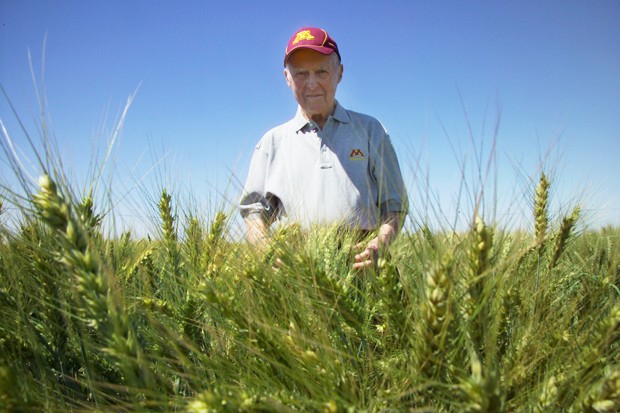Only five people in history have been awarded the Nobel Peace Prize, National Medal of Freedom and the Congressional Gold Medal: Mother Theresa, Martin Luther King Jr., Nelson Mandela , Elie Wiesel and Norman Borlaug. Borlaug, who died of lymphoma in his Dallas home Saturday night at the age of 95, was named one of Time MagazineâÄôs 100 most influential minds of the twentieth century for his solutions to help solve world hunger, and has been credited for saving a billion lives in countries around the world through his innovations. From the farm to the âÄòUâÄô Borlaug came to the University of Minnesota in 1937 from a farm in northern Iowa. Initially intent on attending a small teaching college, a friend convinced him to give the University a shot, BorlaugâÄôs daughter Jeanie Laube, 65, said. âÄúHe bombed the entrance exam,âÄù Laube said. âÄúHowever, he retook the test, and got in. âÄúHe always would go back to the [University] and say to the admissions people: âÄòYou cannot judge people by one test they takeâÄô,âÄù she said. Borlaug was a wrestler for the University âÄî an experience he would often say taught him to work hard and live life with resilience. âÄúWhile IâÄôve been coach, [Borlaug] has spoken to the team about four times,âÄù Gophers wrestling coach J Robinson said. âÄúHe talked about being persistent and never giving up as a wrestler, an athlete and a person.âÄù Borlaug graduated from Minnesota with a bachelorâÄôs degree in forestry, and went on to receive a doctorate degree in plant pathology after hearing a lecture by then-professor E.C. Stakman on plant rust, a disease that can destroy species of plants. âÄúHe loved Minnesota,âÄù Laube said. âÄúMy parents met there. He did all his work there. He was scheduled to be the Grand Marshal in this yearâÄôs Homecoming parade.âÄù From Mexico to the world In 1941, the Rockefeller Foundation established a “survey commission” to go to the rust-ravaged fields of Mexico to conduct an in-depth survey of agricultural practices, headed by BorlaugâÄôs mentor, Stakman. Borlaug joined the project in 1944. Moving to and growing up in Mexico City, his wife and two children would see him three months out of the year, Laube said. Even so, there was no resentment. âÄúWe had a wonderful mother that was able to keep the family together,âÄù Laube said. âÄúWe didnâÄôt know he was changing the world. We thought he was just working.âÄù By 1956 his innovations had helped Mexico double its wheat production. By 1963 it had quadrupled. âÄúNormal wheat would just get taller and fall over,âÄù University Regents professor and personal friend Ronald Phillips said. âÄúBut he bred genes that give it a stiffer stalk and could make use of better nutrient qualities of the soil.âÄù Additional innovations would drastically improve wheat genetics, which he took to Pakistan and India âÄî the âÄúgreen revolution.âÄù His political diplomacy in the region would help solve a starvation crisis, gain him respect and eventually win him the 1970 Nobel Prize. âÄúThe increase in crop production is just unparalleled,âÄù said Ed Runge, professor of soil and crop sciences at Texas A&M University . Runge, who was good friends with Borlaug, played an instrumental role in bringing Borlaug to Texas A&M in 1984. âÄúThe crop production in India is three to four times what it was.âÄù During a visit with Borlaug to India, Laube witnessed the extent of her fatherâÄôs popularity. âÄúMy husband and I went to India with him 13 years ago âĦ I realized that this man is like God over there,âÄù Laube said. âÄúThey would actually roll out a red carpet for him when he would get off a plane. IâÄôve seen that in Mexico, too.âÄù A humble passing Although his accomplishments were great, most of his colleagues remember Borlaug for his humble personality. âÄúHe was such a modest man, you know,âÄù Runge said. âÄúHe had no air about himself and he demanded no protocol. He was a citizen of the world, really.âÄù Ed Price, director of the Borlaug Institute at Oklahoma State , echoed RungeâÄôs sentiment. âÄú[He was] very firm in his convictions,âÄù Price said. âÄú[He was] very studious and hardworking, indefatigable and humble at the same time.âÄù âÄúHe never mentioned any of his awards,âÄù Phillips said. âÄúHe has over 100 honorary doctorates. He has buildings named after him around the world. You would never know.âÄù Borlaug held a vision of ending world hunger, and passed this philosophy on to his children, Laube said. Laube, who works as a community service director and Spanish teacher for two schools in Dallas, said philanthropy is in her blood. âÄúHe was very kind. It didnâÄôt matter who it was,âÄù Laube said. âÄúWhether it was a king, queen âĦ president of a country, or a local garbage man,âÄù she said, âÄúpeople are people, he told us.âÄù Borlaug is survived by his two children, five grandchildren and six great grandchildren âÄî all of whom were with him when he passed away. His youngest great grandchild sat on his lap as he died. Even on his deathbed, Laube said, Borlaug remained humble and committed to helping farmers increase their yields: Borlaug had been mentoring a Ph.D. student from Oklahoma State University on a portable device to help measure nitrogen levels in crops. âÄúFarmer. Get it to the Farmer,âÄù were his last words, Laube said.

Norman Borlaug, Ciudad Obregon, Mexico at CIMMYT wheat research station. March, 2006.
Norman Borlaug leaves behind a legacy of service
Borlaug has been credited for saving a billion lives around the world through his innovations.
by Robert Downs
Published September 14, 2009
0

